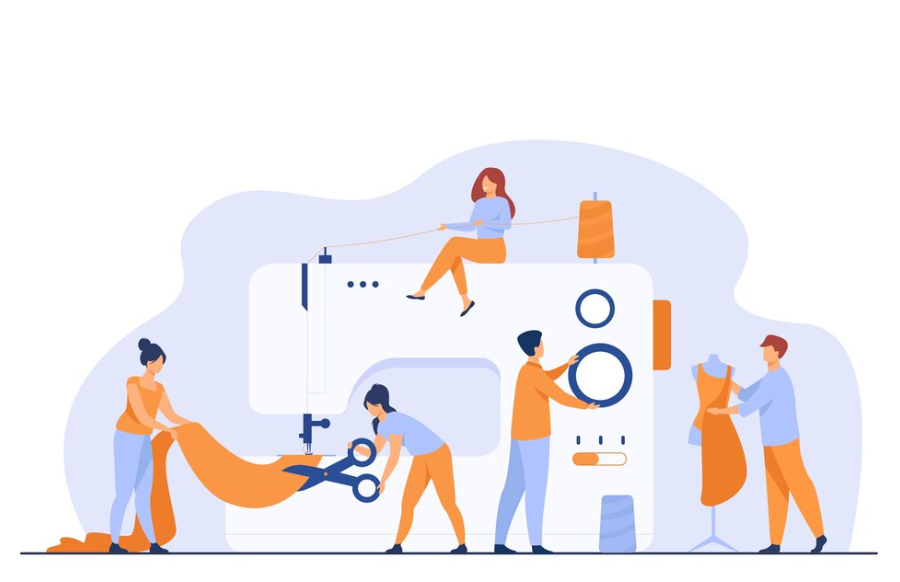
The journey from a picture to a garment involves several key steps. Each phase plays an essential role in bringing the design to life. It is a structured process that starts with an idea and ends with a finished product.
Fashion designers work with a team to make the design come to life. They rely on patterns, fabric selection, and skilled labor. Every stage contributes to the final garment.
Understanding these seven steps helps you see how best custom clothing manufacturers convert a simple picture to a beautiful piece of clothing.
From Picture to Garment: A 7 Step Process
These processes take an initial design idea from the picture and turn it into a finished quality garment.
1. Conceptualization
The process begins with the concept stage. This is when the designers at high-quality custom clothing manufacturers will start creating initial ideas based on the pictures given.
After gathering inspiration, the designer starts sketching. Sketches may go through multiple revisions before a final version is chosen. This sketch is the foundation for the rest of the process.
Once the sketch is final, it serves as a blueprint. It guides the following steps, ensuring that the design translates well into a physical garment.
2. Fabric Selection
After the concept is finalized, the next step is fabric selection. Designers choose fabric based on how it will affect the garment’s structure and appearance. Different fabrics serve different purposes. For instance, some fabrics drape well, while others are more rigid.
Designers often order fabric swatches to test the quality and feel. This ensures the material works well with the design. The fabric selection must align with the garment’s intended function and look.
Once the fabric is chosen, designers plan how much material they will need. They ensure enough is ordered for both the main garment and any prototypes.
3. Pattern Making
Pattern making is when the sketch begins to take shape. Designers or pattern makers create templates for each piece of the garment. These templates guide how the fabric will be cut.
Pattern makers at high-quality custom clothing manufacturers create detailed outlines of each part. These include areas like sleeves, bodices, and collars. The patterns must fit together perfectly, ensuring that the garment will be sewn correctly.
After the patterns are complete, they are tested for accuracy. Pattern testing helps ensure the garment will have the correct proportions. Any mistakes are corrected before moving on to the next phase.
4. Cutting
With patterns finalized, the fabric cutting begins. This step is crucial because any mistakes can result in wasted material. The fabric is carefully cut into the shapes defined by the patterns.
Depending on the production scale of the best custom clothing manufacturers, fabric can be cut by hand or machine. For large-scale production, machines are used to cut multiple layers at once. For custom designs, cutting is usually done by hand to ensure precision.
Once all pieces are cut, they are checked for accuracy. The cut pieces are then sorted and prepared for assembly.
5. Sewing
Sewing is the next step in assembling the garment. Each piece is stitched together following the pattern and sketch. This step gives the garment its structure.
Skilled workers handle the sewing process. They ensure each seam is placed correctly. They also attach any additional details, such as buttons or zippers. Each piece must align perfectly with the design to maintain quality.
Once the sewing is complete, the garment takes its basic form. However, adjustments and finishing touches are often needed before moving to the next stage.
6. Fitting and Adjustments
Once the garment is sewn, it goes through a fitting process. A model or mannequin is used to check how the garment fits. This step helps identify any necessary adjustments.
Fitting is critical to ensure the garment fits properly. Adjustments can include altering seams or modifying certain parts of the garment. If major issues are found, parts of the garment may need to be resewn or adjusted significantly.
Once fitting is complete and the garment meets expectations, it moves on to the final stage of production.
7. Quality Control
The final step is quality control. Every aspect of the garment is inspected. Quality control ensures the garment is free from errors or defects. Workers or machines check stitching, fabric quality, and overall appearance.
If the garment meets all standards, it is approved for packaging and distribution. If issues are found, the garment is sent back for corrections. Quality control helps guarantee that the final product is ready for the market or client.
Once the garment passes inspection, it is packaged and shipped. This completes the process of turning a picture into a real garment.
Conclusion
At AC Ashworth & Company, the best alteration shops near me, our seamless process, from sketch to final product, ensures quality at every step. Whether you’re creating custom pieces or mass-producing designs, we guarantee your vision is brought to life with care. Partner with us to experience exceptional craftsmanship and attention to detail in every garment we produce.